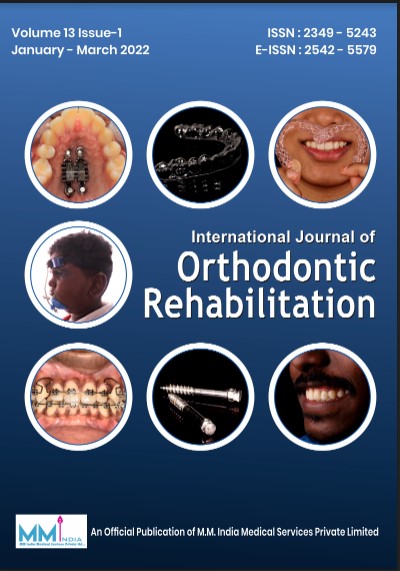COMPARATIVE EVALUATION OF WOUND HEALING FOLLOWING GINGIVECTOMY USING DIODE LASER AND ERBIUM, CHROMIUM-DOPED YTTRIUM, SCANDIUM, GALLIUM AND GARNET (Er:Cr:YSGG) LASER–IN PATIENTS UNDERGOING FIXED ORTHODONTIC TREATMENT-A RANDOMIZED CONTROLLED TRIAL. Original Article
Main Article Content
Abstract
Aim:
The aim of the current study is to compare the healing following gingivectomy procedures using the Diode system and Er:Cr:YSGG lasers in patients undergoing fixed orthodontic treatment.
Methodology:
The study is a single center randomized controlled clinical study with a sample size of 40 patients who underwent gingivectomy using lasers. The patients were divided into two groups randomly (Group A= 20 and Group B= 20). Group A patients had undergone gingivectomy using diode laser (BIOLASE EPIC X,940 nm) and Group B patients had undergone gingivectomy using Er:Cr:YSGG laser (Waterlase,2780nm). The patients were followed at day3, day 7 and day 14. The wound healing was assessed post laser application using a healing index by Landry et al at different time intervals. Data were entered in Microsoft Excel spreadsheet and analyzed using SPSS software (IBM SPSS Statistics, Version 20.0, Armonk, NY: IBM Corp.). Independent t test was used to compare the mean healing index score between the groups. Repeated measures ANOVA and Post hoc Bonferroni test was used for comparison of mean healing index scores of Group A and B at different time periods
Result:
When comparing the healing index at day 3 between the groups, there was no significant difference between the diode laser and erbium laser group (P = 0.24). Similarly at day 7 and at day 14, there were no significant differences between the groups (P= 0.20), (P= 0.18) at day 7 and day 14 respectively. When comparing the healing index score of gingivectomy with diode laser between different time intervals, there was a statistically significant healing was seen at day 14 (P = 0.001). The healing at day 14 was significantly better than day 3 and day 7 in the erbium laser group (P =0.001).
Conclusion:
Within study limits it is concluded that Er:Cr:YSGG lasers have better healing compared to diode lasers following laser assisted gingivectomy although the results are not statistically significant. Thus, the use of laser is an effective treatment approach in the management of orthodontic associate gingival enlargement.
Article Details

This work is licensed under a Creative Commons Attribution-NonCommercial 4.0 International License.
References
Kloehn JS, Pfeifer JS. The effect of orthodontic treatment on the periodontium. Angle Orthod. 1974;44:127-34.
Romero M, Albi M, Bravo LA. Surgical solutions to periodontal complications of orthodontic therapy. J ClinPediatr Dent. 2000;24:159–163.
De Oliveira Guare ́ R, Costa SC, Baeder F, De Souza Merli LA, Dos Santos MT. Drug-induced gingival enlargement: Biofilm control and surgical therapy with gallium–aluminum– arsenide (GaAlAs) diode laser—A 2-year follow-up. Spec Care Dentist. 2010;30:46–52.
Kravitz ND, Kusnoto B. Soft-tissue lasers in orthodontics: an overview. Am J OrthodDentofacialOrthop. 2008; 133:S110–S114.
Öncü E. Comparison of gingivectomy procedures for patient satisfaction: Conventional and diode laser surgery. Selcuk Dent J. 2017;4:6–9.
Robert A Convissar. Priniciples and Practice of Laser Dentistry. Mosby Elsevier 2011:pp 67-70.
Chawla K, Gupta M, Khanna N, Lamba A. Treatment of peri-implantitis around orthodontic miniscrew using Er,Cr: YSGG Laser. J Dent Lasers. 2012;6:66-7

